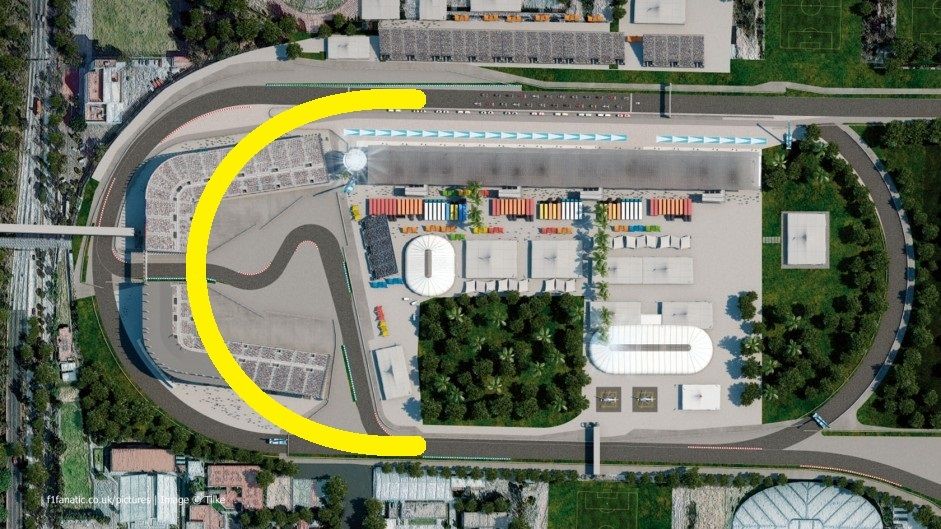Preview Mexico GP
- Login or Register
No account yet? Sign up



Don't know why, it's great for racing, a short sprint race until T1 with people winning/losing positions is better than a short run with everyone in the same position as started!SiLo wrote:That run to turn 1 is ridiculous. For some reason I don't like it when tracks have a very long run to the first corner. I prefer a medium length to turn 1.
Track looks fun to drive though, hopefully we can see lots of overtaking!

Yeah. I sort of wish they could have shifted peraltada in to get more run off and at the same time have the bonus of shortening the straight something like this:SiLo wrote:That run to turn 1 is ridiculous. For some reason I don't like it when tracks have a very long run to the first corner. I prefer a medium length to turn 1.
Track looks fun to drive though, hopefully we can see lots of overtaking!


Ok 135 Watts? I am guessing the cycling machine. right chicken legs? lol jkturbof1 wrote: Well, I'm admittingly not an expert, so I can get things wrong. I do however speak from my own experience as a maniac who loves high intensity cardio. There's a fine line between the maximum "steady-state" aerobic output, and the anaerobic output.
However, you can move that line. For instance I personally moved my line from aprox 100 watt to 135 watt in 3 years (I'll tell you in a second which excercise. It is actually the exact same device used by for instance Alonso, so it has some relevance to F1!). That was very tough to do, and it required everything of my body to improve: lung capacity, heart strength, muscle tension and the way the body can get rid of the lactic acid (yes, even in aerobic state you'll get this in smaller quantities). The length of the excercise usually is 35 minutes, but doubling it, is more then possible. As long as the body has reasonable energy reserves (sugars, fat and proteins) and keeps it burning as efficient, length of the excercise is of little issue. It now takes me equal effort to put out 135 watt then it took 3 years ago to do 100 watt.
What I am getting at is that F1 drivers can do exactly the same. Assume for instance that driving a F1 car requires 100 watt from the driver. Now if he trains to the point he can put out 135 watt, he has a LOT of reserves. It is a simple example, but most races we see drivers come out barely even sweeting and looking as fresh as when they entered the cockpit. This is because their maximum steady-state output is a lot higher then the needed output.
However, you have races where the conditions you have so carefully build your output around, being out of optimal conditions. Malaysia and Singapore for instance have very humid and warm weather. Body temperatures are going to be much higher and outside of the optimal window (sounds like we are talking about tyres!) and it'll take a more effort to reach the same output. The same is true for Mexico: less air, so your "internal combustion" is less. HOWEVER, since you trained to the point that your V02 max creates a much higher output then needed, you can still deliver the needed output.
The cardio device I use is the arm bicycle. You sit upright and you cycle with your arms. It's a complete upper body excercise since your shoulders and chest pull and push in the excercise along with the arms. It's ideal for F1 drivers since it teaches to cope with raised body temperatures and get rid of any waste product in the muscle fibres, as well as making the heart a lot stronger.
You mentioned 200m and 400m sprints. Now 200m is quite on edge, but you cannot run 400m on maximum output (anaeroic + aerobic). I know it's called a sprint, but I dislike that it is given that name since you are not running at full power.Anaerobic respiration is there when there is not enough oxygen in the muscles. This happens at intense excercises like 100m sprinting: you are demanding so much of the muscles the body cannot deliver the oxygen fast enough no matter how hard you breath. At that point you are past your V02 max. Your body will burn what oxygen it has, but beyond that it has to burn fuel without oxygen. Oxygen management is of little consequence on the 100m: of course the less oxygen BELOW your V02max you take in the more you'll put the muscles in anaerobic state and the less output you'll have. However since the race is that quick, 100m, your body will not shut down. It's just breathing in what you can, then down how fast the body can transport to oxygen to your muscles, but your output is your maximum output and that will be much higher then the v02max. You probably even want to be careful with breathing not too hard since that costs energy too. It's simply down to match your breathing to your v02max and beyond that how much power you can generate with the anaerobic system.Oxygen management and efficiency is extremely important in sprinting.
It's a tad different on the 200m: the anaerobic state will last long enough to make life very harsh. With enough training you can keep maximum output. 400m is too much for max output, so you need to lower it a bit in order for the anearobic waste product not to clog your muscle fibres.

Your feeling is right. Long straigths+altitude= McLaren will suffer a lot.bauc wrote:I have a bad feeling about Mclaren's performance on this track
Long straights, sure. Altitude, no. As covered in the engine thread, the altitude will actually slightly increase the amount of power to the MGU-H (counterintuitively). The turbos really do make life a lot better than NAs at altitude.Vasconia wrote:Your feeling is right. Long straigths+altitude= McLaren will suffer a lot.bauc wrote:I have a bad feeling about Mclaren's performance on this track